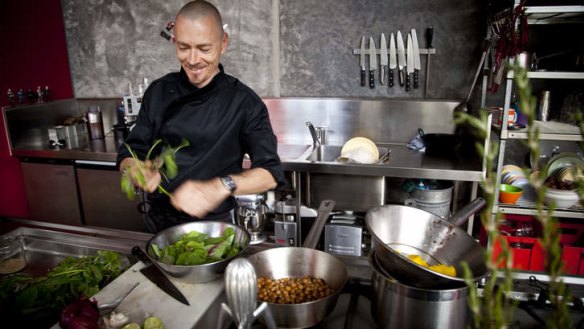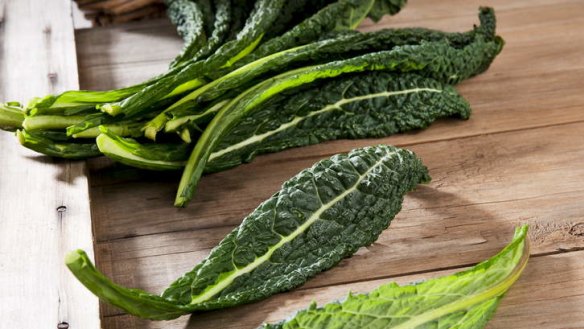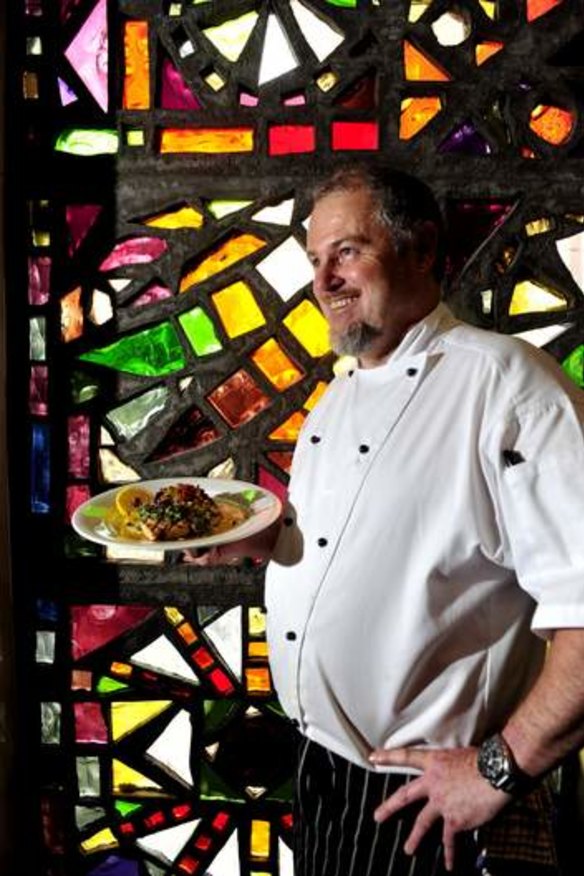Our nutritious harvest

For the 2013 Food and Wine Annual we thought you'd like a taste of groovy edibles that you can grow in Canberra. Consultant dietitian Caroline Salisbury of Braddon suggests that instead of the ''healthiest'', we talk about ''nutrient rich, user friendly and tasty''.
At Floriade this year, South Australian chef Simon Bryant spoke about ethical food and growing his own, including native foods. Bryant, best known as the chef with Maggie Beer on ABC's The Cook and the Chef, described quinoa as a superfood, amino-acid-balanced, low GI and gluten-free. The United Nations named 2013 as International Year of Quinoa and the ancient grain from South America is now being grown in Australia. Who will be the first to raise quinoa in Canberra?
KALE

Black kale (cavolo nero) is being grown in lots of local home gardens. At Benedict House in Queanbeyan, which celebrates things Italianate, two large beds were devoted to slate-grey cavolo nero this year. Salisbury says kale is trendy but not always user-friendly for taste.
Simon Bryant promotes kale as a great source of calcium with a kick of vitamins C and K. As with all brassicas, pests can be an issue, so he never grows kale in the same spot two years running and says good companion plants are beets or onions.
Bryant plants kale in autumn for a winter harvest but says if you can't wait, sneak a few young leaves off early. Add lime to keep acid levels in the soil down and make sure kale isn't planted in heavy soil as it doesn't like wet feet. He sent Food and Wine a recipe.

Simon Bryant's carbonara with kale chips
Serves 4
½ bunch young kale leaves
40 ml extra virgin olive oil
salt flakes
1 x 500g packet bucatini (or your favourite long pasta)
2 tbsp butter
120g free range naturally smoked belly bacon, cut into lardons (pinky sized fingers)
1 brown onion, sliced
6 cloves garlic, chopped
100ml white wine
1 cup real cream from a local dairy bought at fair prices (look after dairy farmers who look after their cows, hit the farmer's market)
6 egg yolks
black pepper
salt flakes
½ bunch of chopped parsley leaves
1 cup grated good quality parmesan
Pinch the stems off the kale, toss the leaves in the olive oil and about a quarter of the parmesan until sort of coated. Spread out well on oven trays coated with baking paper, sprinkle with a little sea salt and bake in 180C oven until crispy (15 odd minutes).
Cook the pasta in a pot of salted simmering water. While this is simmering prepare the sauce.
Heat the butter in a pan, add the bacon and cook until crispy, remove and set aside (keep the butter and rendered bacon oil in the pan). Add the onion, cook till soft for a few minutes, then add the garlic. Deglaze with wine, add the cream and reduce for a few minutes. Pull the pan off the heat and let cool for two to three minutes (so you don't scramble eggs in the next stage).
Fold in the egg yolks with a wooden spoon, working quickly.
Drain the pasta and toss in the sauce with fresh pepper, a pinch of salt, the parsley and the parmesan. Chuck in a bowl and add bacon bits and crispy kale leaves.
MICROGREENS
Dr Justin Morris has spent the past year researching microgreens for seed suppliers Yates. The driving force is a need in the home gardening market due to chefs sprinkling nutritious microgreens on prepared dishes. He says New Zealander Fionna Hill's book How to Grow Microgreens: Nature's Own Superfood (CSIRO Publishing 2011) covers their health attributes and says these tiny seedlings of herbs and vegetables are today's hottest gourmet garnish.
Working in a greenhouse in Sydney, Morris chose an extensive range of greens to see how they would grow. Taste and appearance were determining factors but also the ability for the microgreens to germinate quickly.
From this week, Yates is selling seed packets of amaranth red garnets, cabbage rubies, rocket and mizuna red gems with purple tinge to the leaves and a mustardy taste like wasabi. Sown in a 10-centimetre pot, they take two to three weeks to harvest for a dinner party. The microgreens should be cut when three to five centimetres high.
I have been trialling a sample of the Yates seeds in pots and troughs in my courtyard. They all germinated within five days and it was exciting to watch their growth.
At the National Library after the Canberra 100 Musical Offering 2013 piano performances, head chef at the adjoining Bookplate restaurant Steve Scott served chargrilled marlin on caponata with salmoriglio and microgreens. He has shared the delicious recipe.
Scott likes the look and taste of the baby sorrel and he uses a combination of baby celery, red basil, red garnet and chervil for the contrast of colour and flavour to garnish tarts, eggs benedict and some fish dishes.
Rachel Romney-Brown of Bookplate says they also have a specific Asian microgreens blend for their green mango and roast duck salad.
At Bookplate Scott and Romney-Brown tasted my just-cut microgreens and we liked the mizuna and rocket best. Scott added some of the colourful Yates red cabbage microgreens to his supply of microherbs for our photograph.
Chargrilled marlin on caponata with salmoriglio and microgreens from Bookplate
Serves 4
4 x 150g marlin steaks, cut to size, from a good fish shop
Salmoriglio
1 cup picked and washed oregano leaves
1 clove garlic
2 anchovies, chopped
juice of 1 lemon
150ml extra virgin olive oil
pepper and salt
In a mortar and pestle, crush the oregano leaves, garlic and anchovies into a paste. Add the lemon juice and olive oil to the paste gradually until a thin consistency is reached. Season to taste. Store in the fridge; keeps for one week. Take the salmoriglio out of the fridge 30 minutes before using so the olive oil is not thick.
Caponata
3 tbsp olive oil
1 large eggplant, diced
1 large red onion, diced
2 cloves garlic, chopped
2 stalks celery, diced
1 red capsicum, deseeded and diced
1 yellow capsicum, deseeded and diced
3 tbsp red wine vinegar
400g tinned diced tomatoes
2 tsp castor sugar
60g pitted and chopped green or black olives
1 tbsp salted capers, rinsed
1 handful flat-leaf parsley, chopped
In a heavy-based saucepan heat the oil, add the eggplant and saute for five to 10 minutes. Remove the eggplant from the pan and set aside. In the same pan add the onion and saute for five minutes. Add the garlic and cook for a further two minutes. Add the celery and capsicums and cook for another five minutes. Add the vinegar and tinned tomatoes and cook for 15 minutes. Add the sauteed eggplant and the capers, season with salt and pepper. Then add the parsley. Serve warm or cold.
Chargrill the marlin for two to three minutes on each side on a hot grill or barbecue. It should be served pink in the middle or a little underdone so it doesn't dry out.
Spoon the salmoriglio over the fish just before serving. Sprinkle a generous quantity of microherbs on top of the fish or around the plate and serve immediately with the caponata alongside.
MYSTERY FRUIT
The first backyard produce dinner at A. Baker in New Acton was a fun night where guests were invited to bring edibles that the chefs would cook. They had leeks from Kingston Foreshore and silverbeet grown by their own chefs to accompany smoked pistachios and Marianvale Murray cod. Fennel from the Two Before Ten farm went with Dutton Park duck breast and snowpeas.
The vegetables provided formed the dishes apart from the protein component. Rhubarb from Narrabundah was roasted for a dessert with gingerbread and burnt butter mousse.
The barman mixed cocktails using cumquats from Queanbeyan, mint and ''sun passionfruit'' from Narrabundah. Co-owner of A. Baker Chris Dennis says sun passionfruit is a more elongated (elliptical) version of passionfruit but the seeds are more like pomegranate seeds. We are wondering if it was a grafted variety called ''sunnypash'' or, perhaps, banana passionfruit - can anyone advise?
FIGS
Gourmands adore figs. The most interesting fig trees I've seen this year were growing in the Kingston garden of Gary Rake, who got them by mail order from Diggers in Victoria. These self-fertile French fig trees are St Dominique violette, reportedly grown at Burnley Horticultural College in Melbourne from 1875 and listed in mail-order catalogues until the 1930s.
Near the ornamental gates at Pialligo Plant Farm a fig tree has grown beside a persimmon tree and it is a gift from the birds. It has a heavy first crop. Owners of Pialligo Plant Farm Geoff and Rhondda Cleary have five varieties of fig trees growing in a paddock near their home on site.
Geoff Cleary said the figs in the house garden were badly hit by the mid-October frost of minus 3.8 degrees, their coldest recorded October morning. They will not get a first crop on those trees and the second crop needs to ripen between March and May before the first frosts of 2014.
>> Susan Parsons is a Canberra writer.
Restaurant reviews, news and the hottest openings served to your inbox.
Sign up